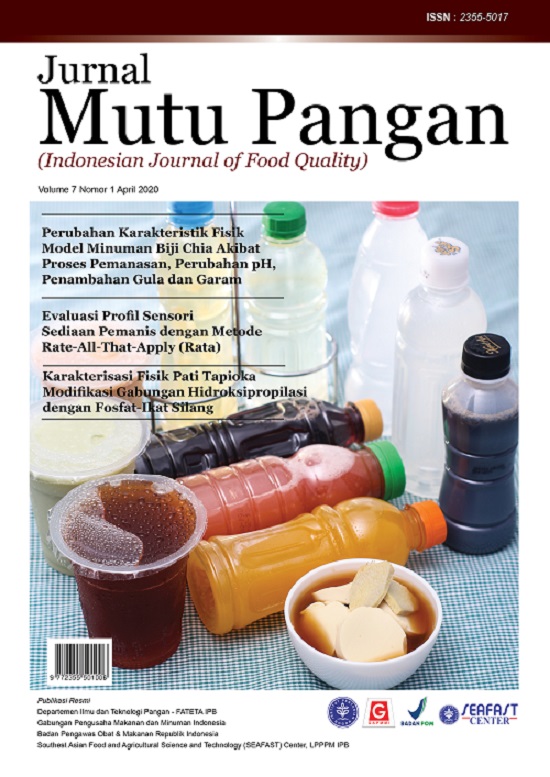Perubahan Karakteristik Fisik Model Minuman Biji Chia Akibat Proses Pemanasan, Perubahan pH, Penambahan Gula dan Garam
Abstract
Chia seed has high nutritional contents and bioactive components potentially used as a food ingredient in beverage products. This study aimed to evaluate the changes of physical characteristics (water absorption capacity or DIA, seed thickness, and viscosity) of chia seeds in beverage models due to heating temperature (70, 90oC) and time (1, 2 hours), pH (3, 5, 7), sugar, (0, 15% ) salt salt (1% KCl and 1% CaCl2) in 3% and 5% chia seeds. The results showed that the pH of the beverage model affected the DIA, viscosity and thickness of the chia seed gum capsules. The higher the pH, the greater the DIA, thickness and viscosity. Sugar concentration and heating time did not affect the physical characteristics of chia seeds, whereas the heating temperature only had a significant effect on pH 3. Addition of CaCl2 1% caused the increase of DSA for approximately twice compared to that of KCl 1%. The addition of chia seeds up to 5% in salt solutions did not affect the DIA.
Downloads
References
Ayerza R, Coates W. 2007. Effect of dietary α-linolenic fatty acid derived from chia when fed as ground seed, whole seed and oil on lipid content and fatty acid composition of rat plasma. Annals of Nutrition and Metabolism. 51(1): 27–34.
[BPOM] Badan Pengawas Obat dan Makanan. 2015. Kategori Pangan. Peraturan Kepala Badan Pengawas Obat dan Makanan Republik Indonesia No. 1.
Brissette CE, Jenkins AL, Choleva L, Vuksan V. 2013. Abstract. The effect of Salvia hispanica L. seeds on weight loss in overweight and obese individuals with type 2 diabetes mellitus. Canadian Journal of Diabetes. 37(4): 64.
Campos MR, Solis NC, Rubio GR, Guerrero LC, Ancona DB. 2014. Chemical and functional properties of chia seed (Salvia hispanica L.) gum. International Journal of Food Science. Article ID 241053, 5 pages.
Coelho MS, Mellado Myrian de las MS. 2014. Chemical Characterization of Chia (Salvia hispanica L.). Journal of Food Nutrutrion Research. 2(5): 263-269.
Craig R. 2004. Application for approval of whole chia (Salvia hispanica L.) seed and ground whole seed as novel food ingredient. http://acnfp.food.gov.uk/sites/ default/files/mnt/drupal_data/sources/files/multimedia/pdfs/chiaapplication.pdf [diakses pada 19 April 2016].
DeRuiter J. 2005. Carboxylic acid structure and Chemistry: Part 1. http://www. auburn.edu/~deruija/pda1_acids1.pdf [diakses pada 22 Mei 2016].
[EC] European Commission. 2009. Authorising the placing on the market of chia seed (Salvia hispanica) as novel food ingredient under Regulation (EC) No 258/97 of the European Parliament and of the Council. (notified under document C(2009) 7645). The Commission of the European Communities. OJ. L 294/14, 11.11.2009.
[EFSA] European Food Safety Authority. 2009. Scientific opinion of the panel on dietetic products nutrition and allergies on a request from the european commission on the safety of ‘chia seed (Salvia hispanica) and ground whole chia seed’ as a food ingredient. The European Food Safety Authority Journal. 996: 3-26.
Fernández I, Ayerza R, Coates W, Vidueiros SM, Slobodianik N, Pallaro AN. 2006. Nutritional characteristics of chia. Actualización en Nutrición. 7: 23-25.
Hedge JE, Hofreiter BT. 1962. Di dalam: Carbohydrate Chemistry 17 (Editor: Whistler RL, Be Miller JN). Academic Press New York.
Hernandez LM. 2012. Gum form chia seeds (Salvia hispanica): Microstructure, physicochemical characterization and application in food industry. [PhD Thesis]. Pontificia Universidad Catolica de Chile.
James. 2010. The four intermolecular forces and how they affect boiling points. http://www.masterorganicchemistry.com/2010/10/01/how-intermolecular-forces-affect-boiling-points/ [diakses pada 20 April 2016].
Khosnevisan K, Barkhi M. 2016. Information about zeta potential. http://www. researchgate.net/publication/275834023 [diakses pada 2 Juni 2016].
Kisgeci J, Jelacic S, Beatovic D, Levic J, Moravcevic D, Zaric V, Gojkovic L. 2011. Evaluation of Basil Seed (Ocimum Basilicum L.). Acta fytotechnica et zootechnica 2: 41-44.
Kurita K. 2006. Chitin and chitosan: functional biopolymers from marine crusta-ceans. Mar Biotechnol (NY). 8(3): 203-226.
Lin KY, Daniel JD, Whistler RL. 1994. Structure of chia seed polysaccharide exudate. Carbohydrate. Polymer. 23:13–18.
Mangesana N, Chikuku RS, Mainza AN, Govender I, van der Westhuizen AP, Narashima M. 2008. The effect of particle size and solids concentration on the rheology of silica sand based suspensions. Journal of the Southern African Institute of Mining and Metallurgy. 108: 237-243.
Pourjavadi A, Aghajani V, Ghasemjadeh H. 2008. Synthesis, Characterization and Swelling Behaviorof Chitosan-Sucroseas a Novel Full Polysaccharide Superabsorbent Hydrogel. Journal of Applied Polymer Science. 109:2648-2655.
Reyes CE, Tecante A, Valdivia MAL. 2008. Dietary fibre content and antioxidant activity of phenolic compounds present in Mexican chia (Salvia hispanica L.) seeds. Food Chemistry. 107(2): 656-663.
Safari A, Kusnandar F, Syamsir E. 2016. Biji Chia: Karakteristik Gum dan Potensi Kesehatannya. Jurnal Pangan. 25(2): 137-146.
Sciarini LS, Maldonado F, Ribotta PD, Pérez GT, León AE. 2009. Chemical composition and functional properties of Gleditsia triacanthos gum. Food Hydrocolloid. 23: 306–313.
Sworn G, Monstanto. 2000. Xanthan gum. Di dalam Stephen PGO, Alistair M, Williams PA, eds. Food Polysaccharides and their applications, edisi ke-2. CRC Press, Boca Raton, Florida.
Timilsena YP, Raju A, Stefan K, Benu A. 2016. Molecular and functional characteristics of purified gum from Australian chia seeds. Carbohydr Polymer. 136: 128-136.
Urakawa H, Mimura M, Kajiwara K. 2002. Diversity and versatility of plant seed xyloglucan. Trends Glycosci Glycotechnology. 14(80): 355-376.
[USDA] United States Department of Agriculture. 2011. National Nutrient Database for Standard Reference, Release 24. Nutrient Data Laboratory Home Page, U.S. Department of Agriculture, Agricultural Research Service.
Vuksan V, Whitman D, Sievenpiper J, Jenkins A, Rogovik A, Bazinet R, Vidgen E, Hanna A. 2007. Supplementation of conventional therapy with the novel grain Salba (Salvia hispanica L.) improves major and emerging cardiovascular risk factors in type 2 diabetes. Diabetes Care. 30(11): 2804-2810.
Vuksan V, Jenkins AL, Dias AG, Lee AS, Jovanovski E, Rogovik AL, and Hanna A. 2010. Reduction in postprandial glucose excursion and prolongation of satiety: possible explanation of the long-term effects of whole grain Salba (Salvia Hispanica L.). European Journal of Clinical Nutrition. 64(4): 436-438.
Vuorinen T, Alen R. 1996. Carbohydrates. Di dalam Eero S, Raimo A, eds. Analytical methods in wood chemistry, pulping and papermaking. Springer, Verlag Berlin Heidelberg.

















